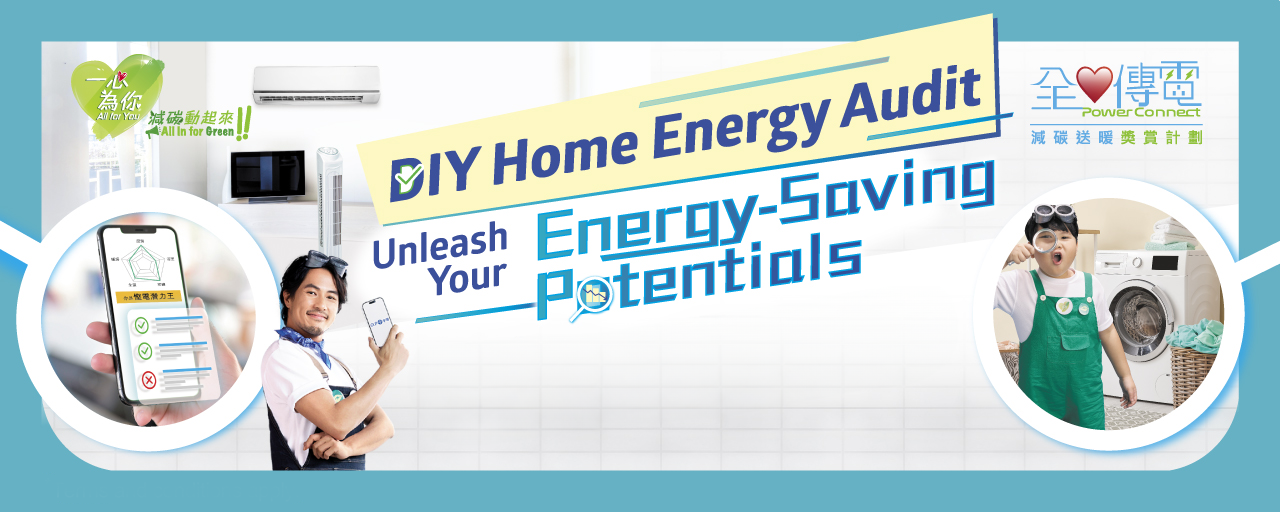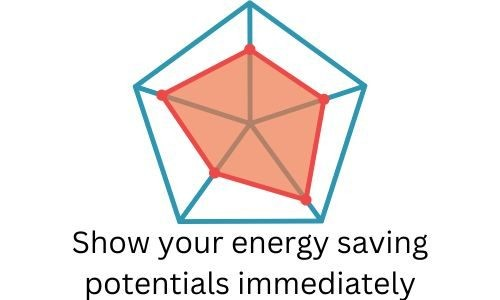

Conduct a DIY Home Energy Audit now!
You can be a house energy “Auditor” too! The "DIY Home Energy Audit" is a 5 minutes simple online quiz to analyse your daily energy usage habits and home layouts instantly. Make use of the tool so you and your family can find out the energy-saving potentials and tips for different home spaces, and save electricity easily.






Energy-Saving Tips
Q1: How full is your refrigerator? Can you see the light inside while open the fridge door?
Best answer: 41%-80%
Tip:
Some peope store as much as possible in the fridge, but this is not fridge friendly. If stored too much, it will block the air flow, affecting the air outlet and cooling effect of the refrigerator, resulting in the refrigerator not being able to perform at its maximum effectiveness.
It is recommended to have 70% full instead, too packed fridge will result in poor air circulation, food can be spoiled easily.
If there is nothing stored in the refrigerator, it is recommended to turn it off instead.
Q2: Is the rubber ring on your refrigerator door in good condition?
Best answer: YES
Tip:
If the torch test shows that you can see the light through the closed fridge door, it proves that the rubber ring of the fridge door is damaged or in poor condition. The aging of the rubber edge will cause cold air to leak out, and it is time to replace it. (Normal situation: the refrigerator door will be closed tightly and no light will pass through)
If the paper test reveals that the paper slipped after closing the refrigerator door, it proves that the rubber ring of the fridge door is damaged or in poor condition. (Normal situation: paper will not fall)
Q3: How many centimetres are reserved between the refrigerator and the surrounding?
Best answer: >10cm
Tip:
There should be space around the refrigerator, no less than 10cm on the back and no less than 5cm on the left and right sides. Do not pile clutter or hang items on the sides of the refrigerator. If there is not enough space left for the refrigerator, it will hinder the heat dissipation on both sides of the refrigerator, causing the temperature on both sides to rise, poor heat dissipation will affect the operating efficiency.
Q4: What kind of cooker do you use in your home?
Best answer: Induction Cooker (Electric)
Tip:
In August 2020, CLP commissioned the School of Energy and Environment of City University of Hong Kong to cook two dishes and one soup using induction cookers and open flame cooking methods to test the energy consumption of the two types of stoves. The same cooking time was used in the test, and the results showed that the energy cost of cooking with electric energy was only about $2, while cooking with open fire cost $3.8. Comparing the carbon dioxide emissions of the two, cooking with electric energy emits 0.83 kilograms, while cooking with open fire emits 0.97 kilograms, a difference of 14%.
Induction cookers are more efficient and generate heat faster; while electric ceramic stoves can only use the heating side to perform heating, so it will be slower to generate heat. Even if both are 2000W, the heating efficiency of an induction cooker will be higher than that of an electric ceramic cooker, which will be relatively more energy efficient.
Q5: How do you boil the water?
Best answer: High Speed Electric Kettle
Tip:
High speed electric kettles can boil water at high speed after being turned on, and do not require long-term use of electricity. They are more energy-efficient than thermal insulation electric kettles.
Insulated electric kettles consume electricity for heating 24 hours a day, a 10-liter insulated electric kettle uses about 2 kilowatt hours of electricity a day, and 730 kilowatt hours of electricity in a year.
Q6: Which type of air conditioner are you using?
Best answer: Inverter Air Conditioner
Tip:
The operation mode of traditional air conditioners is relatively simple, while variable frequency air conditioners can adjust the operating speed and cooling capacity according to different needs, so they are more flexible to use. Helps to save energy by 40% on average throughout the year.
Q7: Will you use air conditioner together with fan?
Best answer: Yes
Tip:
Using a fan in an air-conditioned room can make the air-conditioning more evenly distributed. While maintaining comfort, the target temperature can be appropriately raised to save electricity.
Q8: Do you put electrical devices such as TVs ,computers or game consoles in standby mode when not using?
Best answer: No
Tip:
Standby mode causes the appliance to be in a power-consuming state all the time, seemingly turning off the power and actually being in a power-using state. Therefore, when not using the appliance, we recommended to unplug the power supply to avoid wasting electricity.
Assuming that the standby electricity consumption for an appliance is 1 Watt and a family normally has about 10 to 20 electrical appliances in standby mode, switching off all such standby appliances may reduce household electricity consumption by up to 3%.
Q9: What is the colour of your wall?
Best answer: Bright Colour
Tip:
The colour of the walls should be as light as possible in milky white or light-coloured series with higher reflectivity to increase the diffusion effect of light and thereby reduce the number of lamps required.
Q10: Do you turn off the lights when exit a room even for a short periods of time?
Best answer: Yes
Tip:
Turn off the lights to reduce energy use! For a 100W lamp, turning it off for one hour can save 0.1 watts.
Q11: What temperature do you set for your air conditioner?
Best answer: Between 24˚C – 26˚C
Tip:
How to quickly lower the temperture in the hot summer day?
1. Open the windows.
2. Use the fan/ fan mode under the air conditioner and let it run for 10 minutes.
3. Close the windows and switch to cool mode.
When using air conditioner in summer, the human body feels beeter when the temperature is set between 24℃-26℃. For every 1℃ lower setting in temperature, the consumption will be 3% more.
Q12: How often do you clean your air conditioner filters?
Best answer: Less than 3 months
Tip:
Clean the air conditioner filter every three months or less can prevent aging or accumulation of dust on the unit. If the dust filter is not clean, it will reduce the air intake, and result in reducing the efficinency, the air conditioner will then need to spend more time on cooling, and will consume more electricity.
Q13: How long do you take a shower?
Best answer: Less than 5mins
Tip:
Shortening the shower time can save energy.
Q14: Do you switch off the water heater after showering?
Best answer: Yes
Tip:
There are many electrical appliances in the home that have standby modes and will continue to consume power even when they are not actually in operation. When the hot water reaches the specified temperature but is not turned off, the storage water heater will continue to heat the water up to that temperature from time to time even when the heater is not in use. The result will be a waste on energy.
Q15: How do you use the dehumidifier?
Best answer: Set 2-3 hours timer, Clear up the filter regularly, Power off and unplug, Place it at the middle of room, Use with fan.
Tip:
Place the dehumidifier in the center of the room to allow better air circulation, improve the performance of the dehumidifier thereby reducing the turn on times of the dehumidifier.
Q16: How pack is your washer when in use?
Best answer: Between 70%-80%
Tip:
When cleaning the clothes, about 70%-80% full is best, reserving space for clothes to rotate can improve cleaning performance. But be careful not to put too much, please make sure not to exceed the washing machine loading, otherwise it will reduce efficiency and shorten the lifetime of the machine. Please refer to your instructions for the appropriate washing load for each wash.
Q17: Do you use hot water while washing clothes?
Best answer: Never
Tip:
In genernal, hot water can help to loose the fiber of the clothes and help the cleaning process. If the clothes are not so dirty, it is recommend to use cold water instead, as tot water for laundry is the highest use of enegry in washing, using cold water instead of hot water can reduce energy consumption by up to 90%.
Q18: Which type of lightbulb are you using?
Best answer: LED Light Bulb
Tip:
The most economical option is the LED Light Bulb. At a Compact Fluorescent Lamp of about 1000 lumens, it consumes about 21-23W, while a similar brightness LED Light Bulb is only about 8-9W, which is 60% more energy efficient. The electricity consumption of tungsten lamps every 4 hours is about 0.21 degrees of electricity.
Q19: Which type of battery do you use?
Best answer : Rechargeable Battery
Tip:
Rechargeable battery can be reused far more often than disposable cells. If disposable bettery are used over the long term, the expense will be significantly higher than charging bettery. The rechargeable battery can charge the battery in a short time, saving time and environmental protection.
Q20: How do you charge your mobile phone?
Best answer: Unplug and turn off the socket power after charging is complete
Tip:
The shorter the time it takes for a lithium battery to be fully charged, the less stress it will experience. Therefore, it is recommended to unplug the charging cable or turn off the power of the extension unit immediately after it is fully charged. Because an unplugged transformer will continue to consume electricity.

